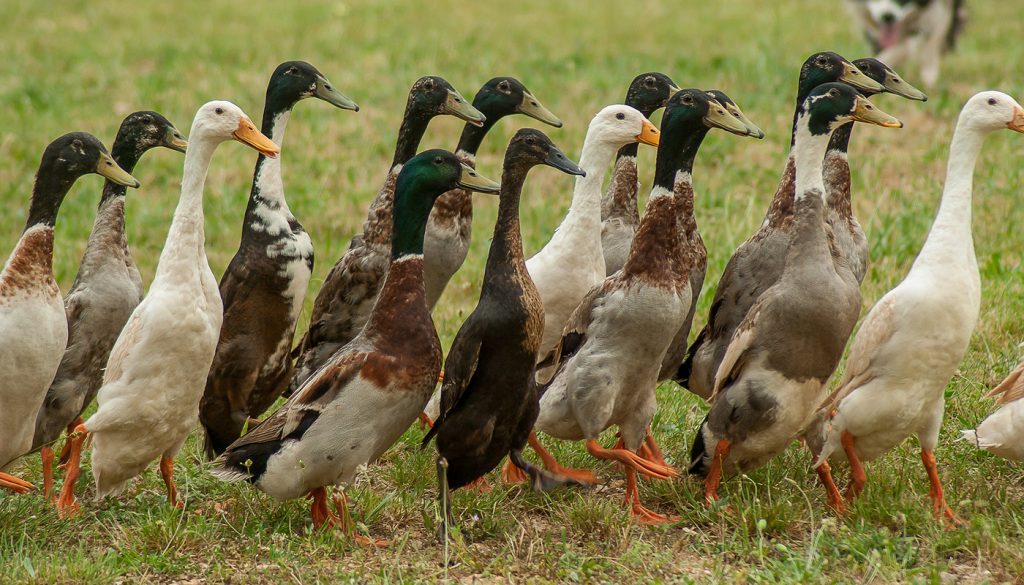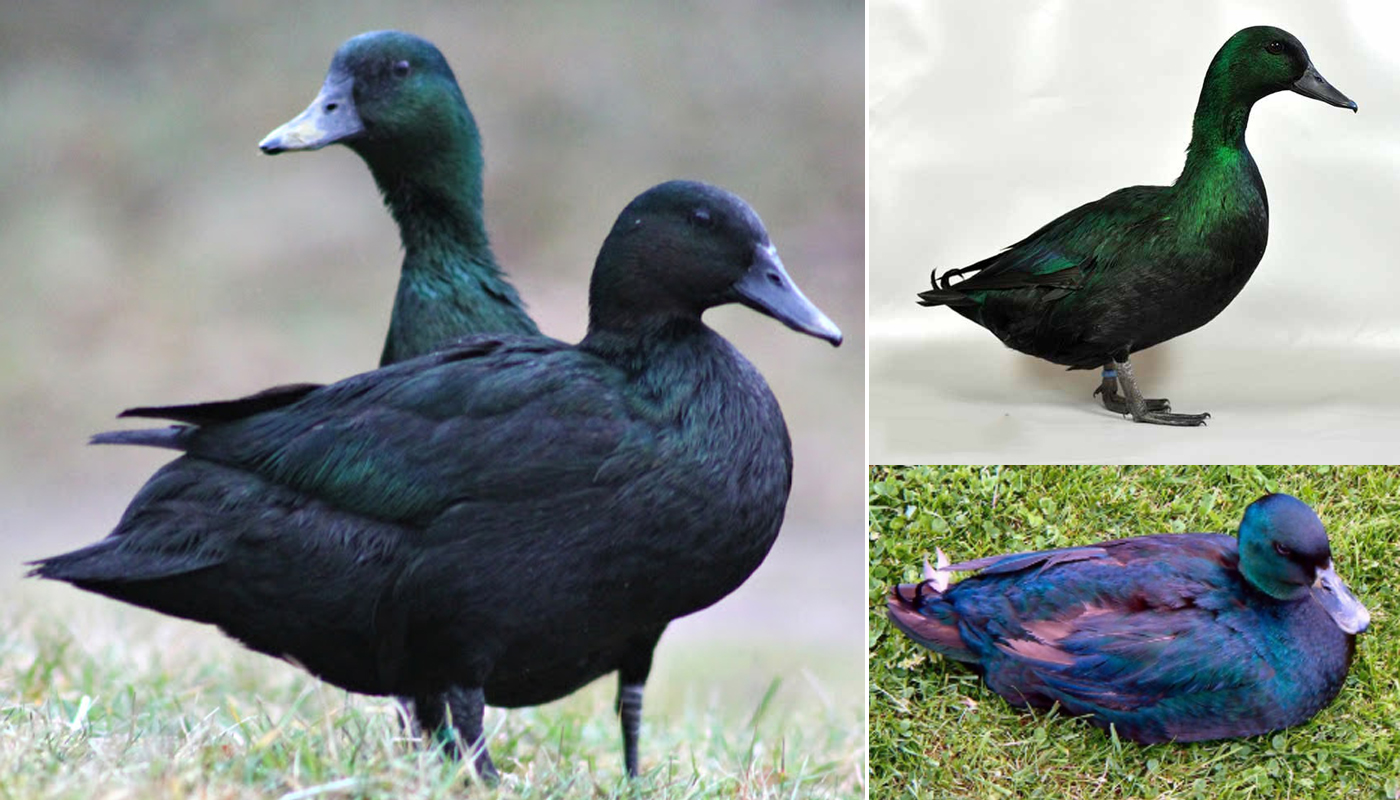
The Indian Runner duck has a very upright posture as such it looks quite tall. It has an elegant long neck and slim body. They are quite an ancient breed of duck with a long history as being a domestic utility breed.
Mainly kept these days for their exceptional egg laying abilities and their dynamic garden pest control. Although they can be a bit skittish they are actually quite a pleasant bird to have around.
They are also a breed that does not require as much water to splash about in like most other ducks. They are quite happy with a small splash pool they can dip their feather in.
GENERAL INFORMATION |
|
|---|---|
| Country of Origin: | Indonesia |
| American Poultry Association: | yes Recognized by the American Poultry Association |
| Duck Category: | Light |
| Duck Class: | – |
| Colors: | Fawn & White, Date of acceptance: 1898 Black, Date of acceptance: 1977 Buff, Date of acceptance: 1977 Cumberland Blue, Date of acceptance: 1977 Penciled, Date of acceptance: 1914 White, Date of acceptance: 1914 Gray, Date of acceptance: 1977 Chocolate, Date of acceptance: 1977 |
| Other names known by: | Indian Runner, Bottle Necks or Penguin Ducks |
| Good starter duck? | Yes |
| You may Also Like: | TOP 10 GOOD STARTER DUCK BREEDS |
| Bantam Variety Available? | No |
| You may Also Like: | 10 BEST BANTAM DUCK BREEDS |
APPEARANCE / IDENTIFICATION
| DUCK BITS | DESCRIPTION | COLOR | |||||||
|---|---|---|---|---|---|---|---|---|---|
| EYES⇒ | Same for M & F | Dark Brown | |||||||
| BILL⇒ | Same for M & F | Yellow | |||||||
| *Black bean tipped | |||||||||
| CRESTED? | No | ||||||||
| LEGS⇒ | Same for M & F Short Length |
Orange | |||||||
| FEET⇒ | Same for M & F Medium Sized |
Orange | |||||||
| WINGS⇒ | Same for M & F | Dependent on the color variety | |||||||
| FEATHERS⇒ | Same for M & F | Dependent on the color variety | |||||||
| SKIN COLOR⇒ | Same for M & F | White | |||||||
| AVERAGE WEIGHT⇒ |
|
||||||||
| *Bean: This is also called the nail. It is a small round bump found at the end of the duck’s bill. It is used for defence and to catch insects. It is almost like a fingernail and is damaged can grow back. It can also get overgrown much like fingernails if they do not have something to grind it down on. | |||||||||
| ** Note: This is an average weight for the male duck and not a guaranteed weight | |||||||||
USE/PURPOSE |
||||||||||||||||||||||||||||||||||||
|---|---|---|---|---|---|---|---|---|---|---|---|---|---|---|---|---|---|---|---|---|---|---|---|---|---|---|---|---|---|---|---|---|---|---|---|---|
Females/Hens⇒ |
Show, Pet, Eggs and meat
|
|||||||||||||||||||||||||||||||||||
Males/Drakes⇒ |
Breeding, Meat, Pet and show bird
|
TEMPERAMENT |
|
|---|---|
| “Skittish and bit unpredictable” | |
| Good with Kids? | I would not leave a child unattended around them |
| You may Also Like: | 10 BEST DUCK BREEDS TO KEEP AS FAMILY PET |
| Flyers? | They are not the strongest flyers and usually do not attempt to fly |
| Noisy Birds? | They are not as noisy as other ducks |
| Interact with other ducks? | They will interact with most any other duck or bird |
| Best duck breeds to mix them with: | Any domesticated duck breed will be fine to mix with this breed . |
| Other animals? | They tend to shy away from other domestic animals. Watch your dogs or cats around your ducks. |
IDEAL ENVIRONMENT |
|
|---|---|
| “Medium to large garden with place for them to waddle around and forage for slugs and snails” | |
| Ideal Garden Size? | Medium to large |
| Can be Confined? | But they do not like to be and may get a bit grumpy |
| Free-Range | They love to be out and about |
| Penned Free-Ranging? | Just make sure there is enough space and fresh foraging ground |
| Foragers | They love to forage for various insects, grubs with their favorite food being a juicy slug or two |
| Endures heat well | Yes |
| Endures cold well | Yes |
| Special Requirements? | No |
| Ideal Duck House: | A nice cozy hutch that can be locked up tight to keep them safe and sound at night. Ensure the hutch has good ventilation and insulation. It must also be large enough to prevent overcrowding of the ducks |
| Ideal Duck Pond: | A nice little splash pool or pond that is not too deep for them to dip in |
| Flock/Paddling Size: | Try to keep the flock at a minimum of two. Ducks like to have a few duck friends about |
| You may Also Like: | 22 Best DOMESTIC DUCK BREEDS |
GOOD TO KNOW |
|
|---|---|
| Special Care/Attention Requirements? | They have no special needs |
| Known Predators: | Check with animal control in your area for known predators |
| Conservations Status: | Not Listed For more information on poultry, conservation status, check the American Livestock Conservancy Website |
| Breeders Clubs: | Indian Runner Duck Club or It is best to check with the American Poultry Association for various clubs and or organizations. |
| Where to buy them: | Purely Poultry, Metzer Farms, Indian Runner Duck Club has a list of breeders or you can check with your local poultry dealers/farms, the APA or check with the American Livestock Conservancy |
| Other: | If you do not want to risk having your ducks shipped check with your local poultry farms for advice on your nearest supplier. |
HISTORY
The Runner or Indian Runner duck’s history can be traced back to over 2000 years ago where they existed in Indo China. There are carvings of this duck on the worlds of ancient Java Temples.
Ducks have been kept and herded in this area of the world for centuries. They would train flocks of ducks to stay in their herders’ site. They would keep an eye on his long bamboo cane that the herder would carry with him. This pole had strips of cloth attached to the one end of it.
Using his herding pole, he would drive the ducks to the rice paddies during there day. There the ducks would keep the rice paddies insect free whilst gleaning the scattered seeds and weeding the paddy.
At night when it was time for the flock to go home the herder would herd them back to where they would be kept in either a protective clay or bamboo structure.
The duck eggs would be collected from the structure early the following morning before the ducks were herded off to the rice paddies again.
For centuries the ducks were chosen for the foraging abilities, they had to be good walkers and prolific egg layers.
As they adapt the breed to these specific standards it was of this quality that was exported to the United Kingdom in the 1850’s. They fast became very popular in Britain due to their unique appearance, highly efficient foraging abilities and great egg laying.
It was not known as the runner duck back them but rather as the Penguin duck due to its waddle and a rather upright stance. This breed has many color varieties but only
Although the Runner duck comes in many colors and was first accepted into the American Standard of Perfection by the American Poultry Association in 1898.
It is mainly kept for its egg production these days, but it is a breed that has been used to create some of the modern breeds of duck.
Health
They have no known health issues. In general ducks are quite healthy with a lot fewer pests than other bird breeds.
- Ducks need water to ensure they do not get “wet feather” disease. This is where the preening gland dries out. Water also stops them from getting pests such as mites, fleas, ticks, lice, etc.
- Well, fed ducks should hardly have any health issues.
- Any birds kept in a flock need to be dewormed. Although ducks are not as prone as other poultry they should still have a de-worming regime. Speak to a local vet or poultry experts for advice. Our article on Healthy Ducks has some great tips and advice on de-worming ducks.
 Gadwall – Wild Dabbling Duck Breed
Gadwall – Wild Dabbling Duck Breed Pekin Duck Breed – Everything You Need to Know
Pekin Duck Breed – Everything You Need to Know Keeping Backyard Ducks – Pros and Cons
Keeping Backyard Ducks – Pros and Cons Orpington Duck Breed – Everything You Need to Know
Orpington Duck Breed – Everything You Need to Know Domestic Duck Breeds – Getting your Ducks in a Row! Part 2
Domestic Duck Breeds – Getting your Ducks in a Row! Part 2 Bantam and Miniature Duck Breeds
Bantam and Miniature Duck Breeds The Best Domestic Duck Breeds for Egg Production
The Best Domestic Duck Breeds for Egg Production East Indie Duck Breed – Everything You Need to Know
East Indie Duck Breed – Everything You Need to Know Duclair Duck Breed – Everything You Need to Know
Duclair Duck Breed – Everything You Need to Know Ancona Duck Breed – Everything You Need to Know
Ancona Duck Breed – Everything You Need to Know Domestic Duck breeds that are or are Fast Becoming Quit Rare
Domestic Duck breeds that are or are Fast Becoming Quit Rare Pomeranian Duck Breed – Everything You Need to Know
Pomeranian Duck Breed – Everything You Need to Know